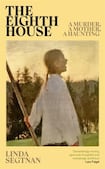
Why are women drawn to true crime? Perhaps if we understand the scenario that led to a woman’s death, we can prevent our own murder. What then, does it mean to become obsessed with a child’s murder when you’re a mother? Not just a mother, but a pregnant mother?
In 1948, nine-year-old Birgitta Sivander was murdered. The culprit was never found. In The Eighth House Segtnan uses archival materials and her own journeys to the town in which the murder occurred to paint a picture of what happened in the time leading up to the murder, and the years that followed. Segtnan is pregnant with her first daughter, heightening both the urgency of the project and the intimacy with which she tells it.
In addition to being thoroughly researched and philosophically vigorous, it is an alarmingly compulsive read. The propulsion of a murder mystery and the countdown to a birth brings the story along quickly.
Despite this narrative intrigue, it is not a novel. The girl at the centre of the story died in brutal circumstances. Comparisons are there to be made with Ghost in the Throat and Into the Night that Flies So Fast, not just formally, but in how these texts use literature to give voice to voiceless individuals from history.
The 100 best Irish books of the 21st century: No 25 to No 1
The 100 best Irish books of the 21st century: No 50 to No 26
The 100 best Irish books of the 21st century: No 100 to No 51
How to End a Story: Collected Diaries by Helen Garner review – ‘small, random stabs of extreme interestingness’ captured on the page
One may question the liberties being taken with a person’s life when all the facts are not available, but it must be acknowledged that all historical books are written with the biases of their author. In texts such as The Eighth House the presence of the author within the narrative allows that bias to be considered. Segtnan includes herself as a character, writing with a confidence that illustrates an author can be both historian and human, amateur detective and dedicated mother. The occultism referenced in the title can be read through this lens. This intimacy elevates the story and shows that sometimes creative writing can stick closer to the truth.
Above all, The Eighth House interrogates the cycles of violence that led to Sivander’s and many other children’s deaths and how this may change. It is an original and captivating addition to a wave of women’s writing subverting the power structures behind the stories they tell.















